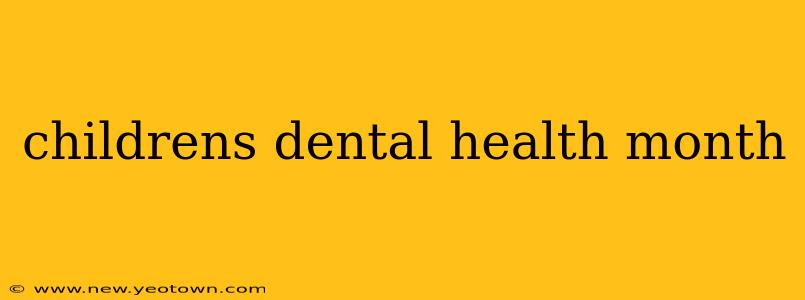February is Children's Dental Health Month, a time dedicated to emphasizing the importance of good oral hygiene from the very first tooth. It's not just about pearly whites; it's about setting the stage for a lifetime of healthy smiles and overall well-being. This isn't just a month-long campaign; it's a reminder to prioritize your child's dental health year-round. Let's dive into the essential aspects of keeping those little chompers healthy and happy.
When Should My Child See a Dentist for the First Time?
This is a question many parents have. The American Academy of Pediatric Dentistry (AAPD) recommends that children see a dentist within six months of their first tooth erupting, or by their first birthday, whichever comes first. Why so early? Because even baby teeth need care! Early dental visits allow the dentist to identify potential issues early on, establish a positive dental experience for your child, and provide guidance on proper oral hygiene techniques. Think of it as laying the foundation for a lifetime of healthy smiles. My own daughter, Lily, had her first check-up at six months, and the experience was surprisingly positive, thanks to the dentist's gentle approach.
What are the Best Ways to Clean a Baby's Teeth?
Cleaning your baby's gums and teeth before they have even erupted is crucial! Even before those first pearly whites appear, gently wiping your baby's gums with a clean, damp gauze pad or a soft, baby-specific toothbrush will help remove any bacteria. Once teeth erupt, switch to a soft-bristled toothbrush designed for babies and toddlers and use a tiny smear of fluoride toothpaste. As your child gets older, increase the amount of toothpaste to a pea-sized amount. Remember, supervision is crucial during brushing to ensure effective cleaning and prevent swallowing excessive toothpaste.
How Do I Teach My Child to Brush Their Teeth Properly?
Teaching your child to brush effectively takes patience and consistency. Make it a fun routine, maybe incorporating songs or a timer. Let them pick out their own toothbrush and toothpaste (with your approval, of course!). Demonstrate the proper brushing technique: gentle, circular motions, covering all surfaces of each tooth. Consider using a timer, aiming for at least two minutes of brushing, twice a day. Positive reinforcement goes a long way!
What Foods and Drinks Should I Avoid Giving My Child?
Sugary drinks and sticky foods are the biggest culprits in childhood cavities. Limit sugary sodas, juices, and candies. Offer water as the primary beverage and opt for healthier snacks like fruits and vegetables. Remember that even seemingly healthy options like dried fruits can be surprisingly sticky and contribute to tooth decay. Monitor your child's snacking habits and encourage regular brushing after meals.
My Child is Scared of the Dentist – What Can I Do?
Dental anxiety is common in children. Start by talking about the dentist in a positive light, reading age-appropriate books about dental visits, and even role-playing the experience with your child using dolls or stuffed animals. Choose a dentist who is known for their gentle approach with children. Many dental practices offer options like sedation for particularly anxious children. Remember, a positive first experience is vital. The key is preparation and positive reinforcement!
What are the Signs of Tooth Decay in Children?
Early detection is key. Look for white or brown spots on your child's teeth, cavities (holes in the teeth), sensitivity to sweets or hot/cold foods, unusual bad breath, or visible gum inflammation. If you notice any of these signs, schedule a dental appointment immediately. Addressing issues early can prevent more extensive treatment in the future.
This Children's Dental Health Month, let's commit to ensuring our children have healthy smiles that will last a lifetime. It's an investment in their overall health and well-being, starting with small, consistent steps. Remember, a healthy smile is a happy smile!

